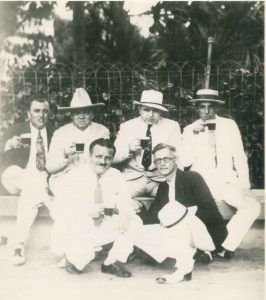
“Capone turned to me. His eyes were twinkling but some of their warmth was gone. ‘Is this a newspaper interview?’ he asked….He fell silent for a moment and then grinned broadly. “[Chicago City Sealer] Serritella says you’re one hundred percent and besides I like that Popeye comic in your newspaper. What do you want to know?’”
So recounts Harry Cyril Read of his first “interview” with gangster Al Capone, as reported in his unpublished manuscript Capone as I Knew Him. The time was 1929, Chicago was rocked by violence resulting from competition in the illegal liquor trade flourishing during Prohibition. It was mere weeks away from the infamous St. Valentine’s Day Massacre, a fact not lost on Read when he would reflect on this initial meeting. Read, editor of one of the two leading newspapers of Chicago – the Chicago American – had decided to use his contacts to get the inside scoop on the man at the center of the escalating violence. His contacts came through.

Harry Cyril Read was born in Chicago in 1892. Beginning with a job reporting for the Cheyenne Leader in Wyoming in 1912, Read’s career as a journalist would span three decades. While he would return to his hometown not long after 1912, the rest of the decade saw him set out on a variety of non-journalistic endeavors. In the intervening years, he would work a variety of industrial jobs, serve in the US Army in the First World War as a Sergeant Major of the 346th Tank Battalion, establish an advertising partnership, and earn a business degree from Northwestern University. In 1921, Read began working as a reporter for the Chicago American, one of two daily Chicago newspapers owned by William Hearst. An intrepid reporter, Read worked his way up the editor post of the newspaper by 1926, coinciding with the bloodiest period of the Prohibition-fueled gang wars in the Windy City. An aggressive newsman who sought to get to the bottom of the bloodshed, Read’s papers highlight numerous hours spent figuring out the politics, personalities, and patterns involved in the underworld. He collected fingerprint records, plotted gang crimes on a map, and plumbed the depths of his contacts for leads. An enterprising investigator, Read would even forge a tense, but cordial relationship with the infamous Al Capone in order to plumb the depths of the ongoing violence and political corruption rocking Chicago. At one point, Read would even go so far as to travel with the bootlegger to Florida and Cuba to maintain a working relationship and in search of a promised scoop. Along the way, he was able to provide details of Capone’s views and actions to the press.
With Capone’s arrest and sentencing for tax evasion in 1931 and the end of Prohibition not long after, the violence in Chicago began to ebb. Read continued to work as a reporter, but became increasingly involved in the labor struggles of the Great Depression. By the 1930s, the Congress of Industrial Organizations and its affiliate, the American Newspaper Guild, had organized Local 71, the Chicago Newspaper Guild. After layoffs in both of the Hearst-owned Chicago newspapers, the Guild called for a strike that began on December 4, 1938. As a leading member, Read was included in a suit filed by the Hearst papers to restrain strike activity in early 1939. The strike would not end until 1940. Despite the end of the strike, Read did not return to his former job, but instead began writing for several labor-affiliated newspapers including the United Auto Worker, the Wage Earner, and as editor of the Michigan CIO News.

In 1945, Read relocated to Washington, DC to accept a position as Assistant to the Secretary-Treasurer of the CIO. It is a position that he would continue to serve in for the rest of his working life, even transitioning with the merger of the American Federation of Labor (AFL) and CIO in 1955. In his this capacity, Read represented the CIO at the United Nations Conference for International Organization in 1948 and at the World Federation of Trade Unions in Rome in 1948. While in Rome, Pope Pius XII received him in private audience. In light of his labor advocacy, Read served as a member of the Association of Catholic Trade Unionists, the Catholic Economic Association, the Catholic Labor Alliance, and the Catholic Inter-racial Council of Washington, DC. Furthermore, his later years were spent working on several books on politics, his experiences, and social commentary. He was also active on health and safety committees in Washington, D.C. being recognized posthumously by the National Safety Council. He passed away in 1957.
His wife, Lucy Read, donated the Harry Cyril Read Papers in 1958. They highlight the life and career of this enterprising journalist, labor and safety advocate, and author.
